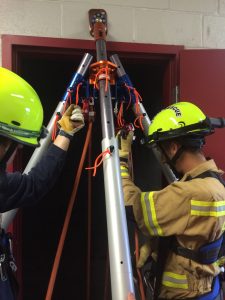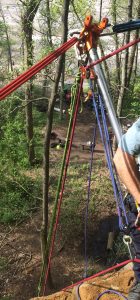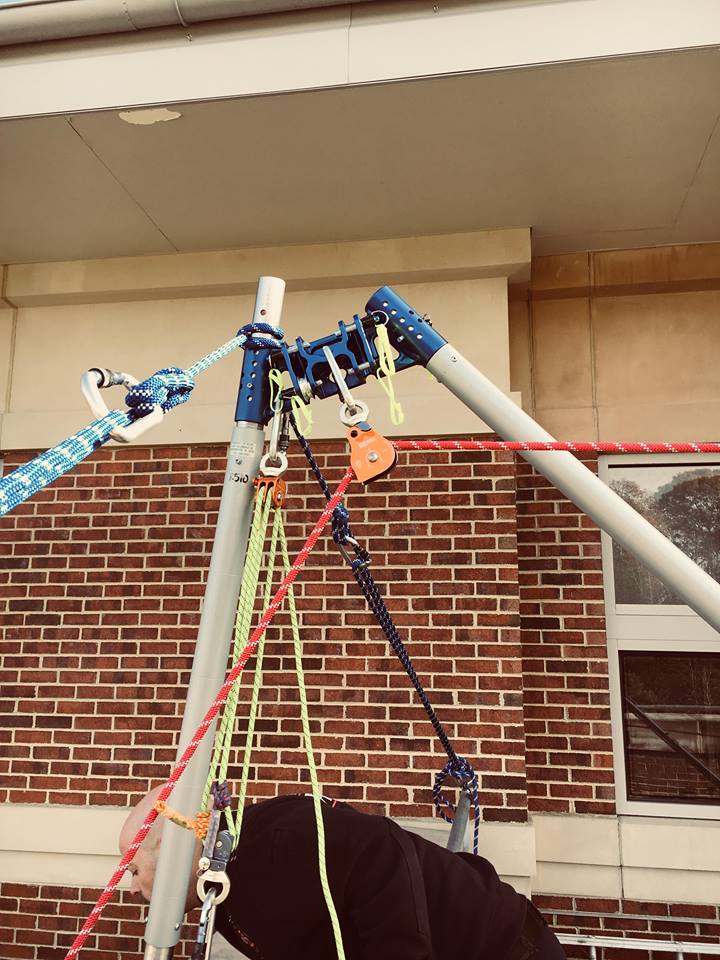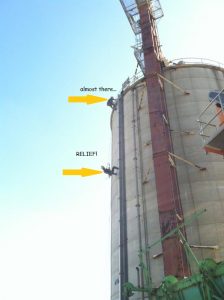There is no secret that the Artificial High Directional has become, and is currently all the craze in the rescue world. These systems can be somewhat costly, and undoubtedly entail a good amount of specialized training; so the question is why have so many teams across the world turned to these tools as a must-have in their rope rescue operation? This article will explore the immense benefits in the most raw and simplistic form. Stick with Rigging Lab Academy in the coming months for continued technical information on how your team can drastically revolutionize rescue operations by imparting an Artificial High Directional (AHD) in your systems.
In order to effectively explore this topic a basic understanding of what exactly an AHD is must be discussed. The Artificial High Directional is a portable system that can be assembled at the site of a rescue. There are two main versions of these systems. The Arizona Vortex, and the Terradaptor are predominantly what is being utilized out in the field. Both systems incorporate several leg pieces, foot pieces, and head assemblies made of lightweight metal material with a significant loading capacity. There are virtually limitless configuration possibilities which will be further explored as this training with Rigging Lab Academy continues. So again the question lies, what makes these so great? Allow me to explain…
Chances are, at some point in your rope rescue training you’ve made a low edge transition similar to the one pictured. If you’re like me, this is often the hardest part of the entire rescue evolution. As you are transitioning the edge, there is an immense amount of pressure as you lean farther, and farther back. Generally one of two things happen at that point. Many a poor soul  reach the “break over” point, and end up inverted, or they take a hard slam against the wall as their footing is lost. Some well-practiced rescuers train themselves to overcome a nasty inversion by taking a few “stutter steps” as they feel themselves reaching the break over point. Either way, this process is often grossly unpleasant at the least, and dangerous at the most. Once the edge has been transitioned and you are in the position of the lower individual in the picture, all of that pressure and discomfort disappear. Why? The simple reason is because the edge that you went over now holds all the pressure and force that your body was just experiencing. The job of the AHD is to artificially elevate that edge. By doing so, the rescuer can easily transition, while experiencing virtually none of the force they experiencing during a low-edge transition. If the operation entails bringing a victim and rescuer back to the top, the AHD provides an easy passage for a litter due to the fact that the rope system is now elevated several feet off the ground. Additionally, the danger of rope rub during a low-edge operation is reduced significantly.
reach the “break over” point, and end up inverted, or they take a hard slam against the wall as their footing is lost. Some well-practiced rescuers train themselves to overcome a nasty inversion by taking a few “stutter steps” as they feel themselves reaching the break over point. Either way, this process is often grossly unpleasant at the least, and dangerous at the most. Once the edge has been transitioned and you are in the position of the lower individual in the picture, all of that pressure and discomfort disappear. Why? The simple reason is because the edge that you went over now holds all the pressure and force that your body was just experiencing. The job of the AHD is to artificially elevate that edge. By doing so, the rescuer can easily transition, while experiencing virtually none of the force they experiencing during a low-edge transition. If the operation entails bringing a victim and rescuer back to the top, the AHD provides an easy passage for a litter due to the fact that the rope system is now elevated several feet off the ground. Additionally, the danger of rope rub during a low-edge operation is reduced significantly.
 While taking the pressure off of the rescuer is a major benefit, there is also another crucial component of the AHD that has rescue teams singing its praises. Versatility. Because these systems are completely portable, there is not a single environment in which they cannot be utilized. When sizing up the scene of a rescue we often attempt to find a natural component such as a large tree, or a structural component such as a steel I-beam to use as a high directional. These are great options however the caveat is they must be accessible and not require a great deal of additional time and effort in order to make them work. That is certainly not always the case. By bringing an AHD, the rescue team has complete control over the location and configuration of a high directional to best suit the needs of the given task. My team has areas that are densely populated urban and industrial hubs, as well as mountainous wilderness with cliff faces. The AHD has no boundaries in either of these environments, and with the proper training by those who utilize it, the AHD will shine anywhere.
While taking the pressure off of the rescuer is a major benefit, there is also another crucial component of the AHD that has rescue teams singing its praises. Versatility. Because these systems are completely portable, there is not a single environment in which they cannot be utilized. When sizing up the scene of a rescue we often attempt to find a natural component such as a large tree, or a structural component such as a steel I-beam to use as a high directional. These are great options however the caveat is they must be accessible and not require a great deal of additional time and effort in order to make them work. That is certainly not always the case. By bringing an AHD, the rescue team has complete control over the location and configuration of a high directional to best suit the needs of the given task. My team has areas that are densely populated urban and industrial hubs, as well as mountainous wilderness with cliff faces. The AHD has no boundaries in either of these environments, and with the proper training by those who utilize it, the AHD will shine anywhere.
In the urban environment, the AHD can be well suited to mitigate difficult situations such as a blind-shaft elevator rescue by serving as both a high directional, and anchor point. In the picture you can see rescuers demonstrating this concept by exercising the “Appalachian Doortex”, developed and taught by Kelly Byrne of Washington, DC. The Artificial High Directional can still be tremendously useful even in the hallway of an office building where there is next to no bombproof anchors that present themselves.











11 thoughts on “What’s the Buzz about the Artificial High Directional?”
There is one environment that AHD’s are not suitable, underground/caves. Transport of any such device is incredibly difficult in most caves due to the nature of narrow passages. Often the pipes won’t even go around a corner. The weight can be very tiring to carry around over difficult terrain. Lastly there is usually many pitches so the need for many AHD’s would be needed. This further exaggerates the before mentioned problems.
773890 1970I like this site really much so significantly wonderful info. 621970
592779 430123This is often a great weblog, could you be interested in working on an interview about just how you developed it? If so e-mail myself! 745439
245525 502575As soon as I detected this internet internet site I went on reddit to share some of the really like with them. 325351
680217 754225Hello! I just wish to give a huge thumbs up for the great information youve gotten right here on this post. I will likely be coming back to your weblog for much more soon. 883188
443804 623693I adore foregathering helpful info, this post has got me even a lot more info! . 728262
Kada naudinga atlikti pastato sandarumo testą?
Statant pastatą, siekiant užkirsti kelią galimiems sandarumo defektams; Renovuojant pastatą nustatomos pastato nesandarumo vietos; Sertifikuojant naują, A, A+, A++ energinio efektyvumo pastatą, privaloma patikrinti
jo sandarumą; Įsigyjant naujos ar senos statybos būstą.
O Jones, Richard B. 20% Chance of Rain introduction to exotic option pricing Peter Buchen.
Good day! I simply would like to give a huge thumbs up for the nice info you could have right here on this post. I might be coming back to your blog for more soon.
Hello there, I discovered your website by way of Google while searching for a similar subject, your website came up, it appears to be like great. I’ve bookmarked it in my google bookmarks.
Dede torun siki XXX Videos Porn Movies BANGBROS Katia Loves Spring Break 2017 with Shag Bus
(bb15961) 12:00. 66% Pornet Xxxxbf Bbw Com.
Stepmom homosexual girl with 2 y. 3:56. 98% Aeroplane Porn Ornhub Com سکس زیبا.
Smalltits dutch adolescent jizz 10:10. 66%.
Comments are closed.